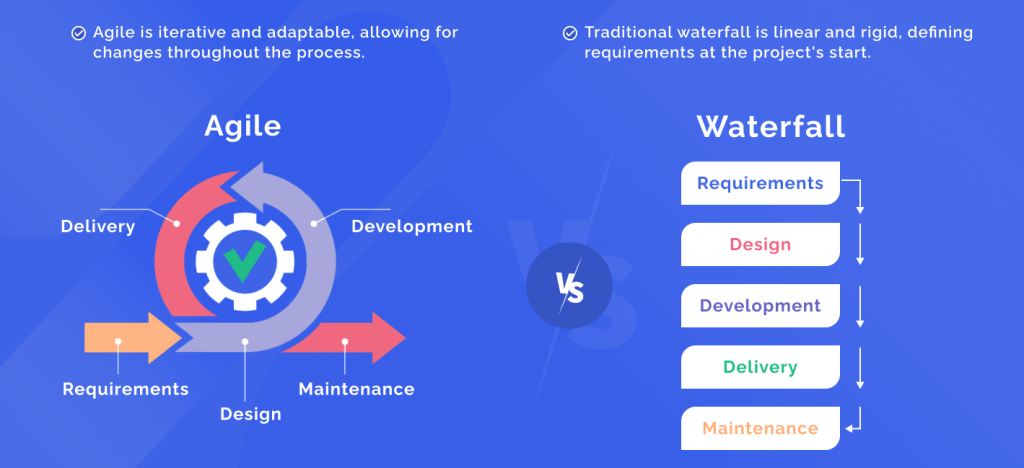Agile software development is transforming the way we create digital solutions. With its flexibility, adaptability, and collaborative approach, agile methodologies have revolutionized the software development landscape. In this blog, we will explore the key principles of agile software development, the benefits of agile software development and how they can be leveraged to enhance productivity, efficiency, and customer satisfaction.
Unlike traditional waterfall methods, which follow a linear, sequential process, agile development follows an iterative and incremental approach. It emphasizes close collaboration between cross-functional teams, continuous feedback, and the ability to adapt to changing requirements.
By incorporating agile practices, such as Scrum and Kanban, organizations can deliver high-quality software faster, reduce risks, and respond effectively to market demands. Agile methodologies also promote greater transparency, allowing stakeholders to have a clear view of the project’s progress at all times.
Read till the end of the blog as we delve deeper into the world of agile software development and explore how it has unlocked new possibilities for creating innovative and user-centric digital solutions. Learn how we as a top agile software development company, can positively impact your organization’s ability to deliver successful software projects.
What Is Agile Software Development?
Agile software development is an iterative and gradual approach to software development that focuses on delivering high-quality software solutions quickly and efficiently. Unlike traditional waterfall methods, which follow a linear, sequential process, agile development follows a dynamic and flexible approach. It emphasizes close collaboration between cross-functional teams, continuous feedback, and the ability to adapt to changing requirements.
Agile methodologies, such as Scrum, Kanban, and Lean, provide a framework for implementing agile practices in software development projects. These methodologies promote transparency, flexibility, and collaboration, enabling teams to respond effectively to evolving customer needs and market demands. By breaking down complex projects into smaller, manageable tasks, agile development enables teams to deliver incremental value and prioritize features based on customer feedback.
The Principles Of Agile Software Development
Agile software development is guided by a set of core principles that drive its success. These principles include:
1. Customer collaboration over contract negotiation
Agile development places a strong emphasis on involving customers throughout the development process. By collaborating closely with customers, teams better understand their needs and can deliver solutions that meet or exceed expectations.
2. Working software over comprehensive documentation
While documentation is essential, agile development prioritises delivering working software over extensive documentation. This allows teams to focus on creating tangible value for customers and responding quickly to their changing needs.
3. Individuals and interactions over processes and tools
Agile development values the contributions and interactions of individuals within a team. By fostering a collaborative and supportive environment, teams can maximize their potential and deliver high-quality software.
4. Responding to change over following a plan
Agile methodologies recognize that requirements and priorities can change throughout the development process. Instead of rigidly following a predetermined plan, agile teams embrace change and adjust their approach accordingly.
5. Continuous delivery of valuable software
Agile development promotes the regular and frequent delivery of working software. By delivering incremental value to customers, teams can gather feedback and make necessary adjustments to ensure the final product meets expectations.
Agile Vs. Traditional Waterfall Development

Agile software development differs significantly from traditional waterfall development in several critical aspects. While the waterfall model follows a linear, sequential approach, with each phase dependent on the completion of the previous one, agile development employs an iterative and incremental approach.
In traditional waterfall development, the requirements are defined at the beginning of the project, and changes to these requirements are typically challenging to accommodate. This can lead to delays and unexpected issues when the final product is delivered. In contrast, agile development allows for flexibility and adaptability by breaking down the project into smaller, manageable iterations. This enables teams to respond quickly to changing requirements and deliver working software at regular intervals.
Another fundamental difference is the level of collaboration and communication between team members and stakeholders. In waterfall development, communication tends to be limited, with minimal interaction between the development team and customers until the final product is delivered. Agile development, on the other hand, emphasizes close collaboration and continuous feedback throughout the development process. This fosters a more collaborative and customer-centric approach, resulting in higher customer satisfaction and better alignment with their needs.
Benefits Of Agile Software Development
The benefits of agile software development are plenty. Agile software development offers numerous benefits for organizations looking to enhance their software development processes. These benefits include:
1. Faster time to market
Agile methodologies adopt an iterative and incremental approach. It enables teams to deliver working software faster. The ability to prioritize features based on customer feedback and adjust the development plan accordingly allows teams to adapt quickly to changing market conditions and seize opportunities.
2. Reduced risks
Agile development promotes continuous testing and integration throughout the development process, reducing the likelihood of major issues or failures at the end of the project. By identifying and addressing potential problems early on, teams can mitigate risks and ensure a smoother development process.
3. Greater customer satisfaction
Agile development places a strong emphasis on customer collaboration and continuous feedback. By involving customers throughout the development process, teams can gain a better understanding of their needs and deliver solutions that meet or exceed expectations. This leads to higher customer satisfaction and increased loyalty.
4. Improved transparency
Agile methodologies promote transparency by providing stakeholders with a clear view of the project’s progress at all times. Regularly delivering working software and involving stakeholders in the decision-making process ensures that everyone is aligned and informed, fostering a sense of trust and accountability.
5. Enhanced teamwork and collaboration
Agile development promotes cross-functional teams and encourages collaboration and knowledge sharing. By breaking down silos and fostering a collaborative environment, teams can leverage their collective expertise and deliver high-quality software.
Agile Software Development Methodologies – Scrum, Kanban, and Lean

Agile software development encompasses various methodologies, each with its unique approach and principles. Some of the most widely adopted agile methodologies include Scrum, Kanban, and Lean.
Benefits of Scrum Methodology In Agile Software Development
Scrum is an iterative and incremental agile methodology that focuses on delivering value in short iterations called sprints. It divides the project into small, manageable tasks called user stories, which are prioritized and assigned to the development team. Daily stand-up meetings, sprint planning, and sprint reviews ensure continuous communication and progress tracking.
Benefits of Kanban Methodology In Agile Software Development
Kanban is a visual workflow management methodology that provides a clear view of the development process. It utilizes a Kanban board to visualize tasks and their status, allowing teams to understand the flow of work and identify bottlenecks or areas for improvement. Kanban emphasizes limiting work in progress and promoting a smooth and efficient workflow.
Benefits of Lean Methodology In Agile Software Development
Lean software development aims to eliminate waste and maximize value by focusing on delivering what the customer truly needs. It emphasizes continuous improvement, the elimination of non-essential activities, and a holistic view of the development process. Lean principles, such as reducing defects, improving cycle time, and fostering a culture of learning, drive efficiency and quality.
Optimizing Your Agile Journey: Delivering Value Fast, Efficiently, and Cost-Effectively
Implementing Agile is not just about adopting a methodology; it’s about unlocking a smarter, faster approach to software development. We’ve helped numerous organizations leverage Agile’s power to:
1. Reduce Development Costs
By prioritizing high-value features and iterating quickly, we minimize rework and deliver functionality that truly matters.
2. Accelerate Time to Market
Frequent releases and continuous feedback loops enable us to get your software to users faster, giving you a competitive edge.
3. Enhance Project Visibility
Our collaborative approach and focus on transparency keep stakeholders informed and aligned throughout the process.
How We Implement Agile Software Development
Implementing Agile is not just about adopting a methodology; it’s about unlocking a smarter, faster approach to software development. Adopting agile methodologies can help to quickly respond to changes in the market and customer needs. The benefits of Agile software development also include collaboration, communication, and iterative development. This helps teams to develop products more efficiently and with fewer errors.
Implementing agile software development practices requires careful planning and a commitment to change. Here are some key steps to consider:
1. Educate and train your team
Ensure that your team members have a solid understanding of agile principles and methodologies. Provide training and resources to empower them to embrace the agile mindset and practices.
2. Start small and iterate
Begin by implementing agile practices in a small project or team. This allows you to test and refine your approach without disrupting the entire organization. Once you have proven the benefits of agile development, gradually scale up and introduce it to other teams or projects.
3. Establish cross-functional teams
Create cross-functional teams that include members with diverse skills and expertise. This promotes collaboration, knowledge sharing, and a holistic view of the development process.
4. Encourage open communication
Foster a culture of open communication and transparency. Encourage team members to share ideas, concerns, and feedback openly, and ensure that stakeholders are involved throughout the development process.
5. Empower teams to make decisions
Give teams the autonomy and authority to make decisions and prioritize work based on customer needs. This encourages accountability and ownership, leading to higher quality and more customer-centric solutions.
6. Continuously measure and improve
Implement metrics and feedback loops to measure and track the progress and effectiveness of agile practices. Regularly review and reflect on the results, identify areas for improvement, and make necessary adjustments to optimize the development process.
Agile Software Development Tools & Technologies

Numerous tools and technologies are available to support agile software development practices. These tools facilitate collaboration, project management, and communication within agile teams. Some popular agile software development tools include:
1. Project management tools
Tools like Jira, Trello, and Asana provide features specifically designed for agile project management. They allow teams to create and manage tasks, track progress, assign user stories, and collaborate effectively.
2. Version control systems
Version control systems like Git and SVN enable teams to manage and track changes to the source code. They provide a centralized repository where team members can collaborate, review code, and ensure version control.
3. Continuous integration and deployment tools
Tools like Jenkins, CircleCI, and Travis CI automate the process of integrating and deploying code changes. They ensure that software builds are tested, validated, and deployed consistently, promoting a smooth and efficient development workflow.
4. Collaboration and communication tools
Tools like Slack, Microsoft Teams, and Google Workspace facilitate real-time collaboration and communication within agile teams. They provide features for instant messaging, file sharing, video conferencing, and project collaboration, enabling teams to work seamlessly together regardless of their physical location.
Agile Project Management & Collaboration
Agile project management and collaboration are crucial for the success of agile software development. Here are some key aspects to consider:
1. Daily stand-up meetings
Daily stand-up meetings, also known as daily scrums, which are short, focused meetings where team members provide updates on their progress, discuss any challenges or roadblocks and align their efforts for the day. These meetings promote communication, collaboration, and accountability.
2. Sprint planning and reviews
Sprint planning meetings occur at the beginning of each sprint and involve the entire team. During these meetings, the team defines the goals and priorities for the upcoming sprint and determines the tasks to be completed. Sprint reviews, on the other hand, occur at the end of each sprint and involve stakeholders. The team presents the work completed during the sprint, gathers feedback, and collaborates on any necessary adjustments.
3. Retrospectives
Retrospectives are regular meetings where the team reflects on the past sprint or project and identifies areas for improvement. They provide an opportunity to celebrate successes, discuss challenges, and brainstorm ideas for enhancing the development process.
4. Visualizing work
Visualizing work using tools like Kanban boards or Scrum boards helps teams track progress, identify bottlenecks, and ensure a smooth workflow. These visual representations provide transparency and facilitate collaboration and communication within the team.
Agile Software Development Success Stories
Agile software development has proven successful for numerous organizations across different industries. Here are a few notable success stories:
1. Spotify
Spotify, the popular music streaming platform, adopted agile practices to enhance collaboration, improve time to market, and deliver a personalized user experience. By organizing teams into small, autonomous squads, Spotify was able to respond quickly to user feedback and adapt its platform to changing market demands.
2. Amazon
Amazon adopted agile software development to continuously innovate and deliver new features and services. By implementing agile methodologies, Amazon could rapidly experiment, gather customer feedback, and make data-driven decisions to optimize its e-commerce platform and enhance the customer experience.
3. Netflix
Netflix, the leading streaming service, attributes its success to its agile approach to software development. By adopting agile practices, Netflix can iterate quickly, test new features, and gather user feedback to improve its platform and provide a seamless streaming experience continuously.
Conclusion
Agile software development has unlocked new possibilities for creating innovative and user-centric digital solutions. By adopting an iterative and incremental approach, we can deliver high-quality software faster, reduce risks, and respond effectively to market demands. Agile methodologies promote collaboration, transparency, and continuous improvement, enabling teams to create value for customers and drive business success. By adopting agile software development practices, organizations can revolutionize the way they create digital solutions and stay ahead in today’s rapidly evolving technology landscape.
Take Your Web Development Up a Notch with Aipxperts’ Agile Team!
Tired of slow web development that feels stuck in the mud? Stop struggling and rocket your project forward with Aipxperts! At Aipxperts our team is well-equipped with all the agile methodologies that are required to fastrack the project and deliver it on time.
With Aipxperts, you’ll:
1. Launch your web app faster
We help you get things up and running quickly, so you can start collecting feedback and making improvements right away.
2. Work smarter, not harder
Agile is all about ditching the endless paperwork and focusing on what matters: building a great website.
3. Build a better team
Agile brings everyone together, from designers to developers. We’ll help your team communicate better and work as one, making development a breeze.
4. Save money and get more ROI for the money you spend
Agile helps you avoid costly mistakes and adapt to changes easily.
Contact us today and let us help you streamline your project with our Agile web and mobile app development services.
Benefits of agile software development | Hire experienced agile software development teams for your projects. Contact us for project estimates and enjoy a 15-day risk-free trial period.











